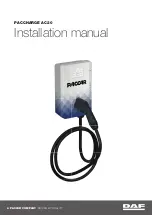
Operating Instructions Booster WA 121545
5
Date: 21.09.2017
8200510 BA / EN
4 Operation
Operation of the booster is not required for daily use.
Only when the battery type is changed (for possible battery types, refer to
Section 5.1), during initial start-up or when retrofitting accessories do one-
time settings have to be configured (see Section 8).
5 Technical details
5.1 Electrical details
Charging curve
IUoU (time and current-dependent switchover to
trickle charge)
Battery types
4 curves can be set from buttons:
Lead-acid battery:
14.4V / 13.4V
Lead-gel battery:
14.4V / 13.8V
AGM battery:
14.7V / 13.7V
Lithium battery:
14.4V constant
(Voltages without/with temperature sensor at 25
C)
Temperature compensa-
tion
In conjunction with optional temperature sensor
(automatic detection): --24mV/
C @ 25
C
Max. charge voltage (U
Charge
) limited to 15.0V
Input voltage (U
e
)
12.0V to 15.0V (for max. charge current) for
input curve C1
Max. charge current
The charge current depends on setting ”Max.
Output” and ratio input voltage U
e
to charge vol-
tage U
Charge
at the output:
Adjustment
Charge Current
”Max.Output”
U
e
/ U
Charge
12.2V / 14.7V
U
e
/ U
Charge
12.2V / 12.5V
U
e
/ U
Charge
14.6V / 14.7V
U
e
/ U
Charge
14.6V/12.5V
45 A
45 A
45 A
45 A
45 A
55 A
45 A
54 A
55 A
55 A
63 A
45 A
54 A
56 A
63 A
70 A
45 A
54 A
56 A
70 A
This means the maximum charge current (
to
70 A
) is possible when the alternator is delive-
ring full voltage (14.6V) and the leisure area
battery is discharged (refer to last column).
Measurement: Vehicle with LiMa voltage 12.6V
to 15.0V; voltage drop on the cable to the star-
ter battery: 0.4V; Leisure area battery: 14,7 V
(almost fully charged) or 12.5V (almost flat)
Maximum input current
60 to 65 A
Efficiency
²
93% (for max. charge current)
















































